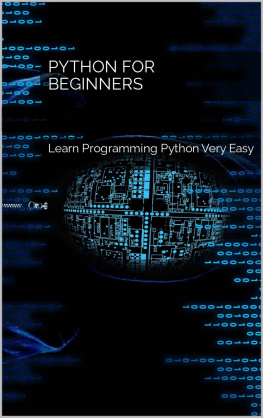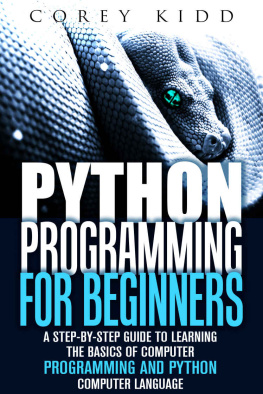Zane - PYTHON PROGRAMMING for beginners: The easy and complete step-by-step guide to learn the basics of Python. With tips, tricks and practical examples
Here you can read online Zane - PYTHON PROGRAMMING for beginners: The easy and complete step-by-step guide to learn the basics of Python. With tips, tricks and practical examples full text of the book (entire story) in english for free. Download pdf and epub, get meaning, cover and reviews about this ebook. year: 2020, genre: Home and family. Description of the work, (preface) as well as reviews are available. Best literature library LitArk.com created for fans of good reading and offers a wide selection of genres:
Romance novel
Science fiction
Adventure
Detective
Science
History
Home and family
Prose
Art
Politics
Computer
Non-fiction
Religion
Business
Children
Humor
Choose a favorite category and find really read worthwhile books. Enjoy immersion in the world of imagination, feel the emotions of the characters or learn something new for yourself, make an fascinating discovery.

- Book:PYTHON PROGRAMMING for beginners: The easy and complete step-by-step guide to learn the basics of Python. With tips, tricks and practical examples
- Author:
- Genre:
- Year:2020
- Rating:4 / 5
- Favourites:Add to favourites
- Your mark:
- 80
- 1
- 2
- 3
- 4
- 5
PYTHON PROGRAMMING for beginners: The easy and complete step-by-step guide to learn the basics of Python. With tips, tricks and practical examples: summary, description and annotation
We offer to read an annotation, description, summary or preface (depends on what the author of the book "PYTHON PROGRAMMING for beginners: The easy and complete step-by-step guide to learn the basics of Python. With tips, tricks and practical examples" wrote himself). If you haven't found the necessary information about the book — write in the comments, we will try to find it.
PYTHON PROGRAMMING for beginners: The easy and complete step-by-step guide to learn the basics of Python. With tips, tricks and practical examples — read online for free the complete book (whole text) full work
Below is the text of the book, divided by pages. System saving the place of the last page read, allows you to conveniently read the book "PYTHON PROGRAMMING for beginners: The easy and complete step-by-step guide to learn the basics of Python. With tips, tricks and practical examples" online for free, without having to search again every time where you left off. Put a bookmark, and you can go to the page where you finished reading at any time.
Font size:
Interval:
Bookmark:
Table of Contents
Python programming sounds scary but it really isnt. The hardest part is in choosing which of the languages you want to learn because there are so many to choose from. Python is one of the easiest of all of computer programming languages; indeed, pretty much everything you need is right there, at your disposal. All you need to do is learn how to use what the program gives you to write programs.
Python is simple; much simpler than many of the other languages and once you have learned it you will find it much easier to move on to more advanced Python or to another language altogether. Python provides you with the framework and libraries that you need to do just about anything that you want to do. If that werent enough, Python also has a very large community full of people who just want to help you and put you in the right place.
Python is the chosen language of many different types of people security testers, data scientists, web app developers, etc. Most of the big applications that you use on a regular basis today are written in Python, including YouTube, the largest video-sharing app in the world.
There are a lot of great coding languages out there that you can work with, but none of them can compare to working with Python. Make sure that you read through this guidebook carefully so you can learn how to write some of your own codes with this amazing language today.
Python is a high level language and one of the most readable languages in this category. It is designed to be learned and used easily. Python programs use nearly regular English statements and simple syntax.
Python is an interpreted language, which means that it uses an interpreter to convert codes and statements into machine-readable byte codes.
Learning a new programming language can be a great experience. You may want to learn it so you can know more things about your computer and understand how it works, how a website works, and perhaps you want to learn so you can create your own applications and programs. But if you have never worked with your computer in this way or with coding in the past, then it is hard to figure out how to get started. With a little search, you will notice that there are many coding languages available that you can work with besides Python. From Java to C++ and so much more, its hard to determine which coding language is the best for you.
As a beginner and someone who has never done anything with coding in the past, Python is one of the best coding languages to work with. Python has long been considered a beginner's language because it is so easy to learn and you will be able to understand it right from the beginning. This is just one of the many reasons why you should choose to work with Python. You will also like there is a large active community devoted to this programming language and whats good is that its open source so you can get started without literally having to pay anything. This language will also work on any operating system so it wont matter which computer you want to use the language on.
Despite being the coding language that beginners like to work with, this doesn't mean that there aren't a lot of advantages that come with working with this language. Python on its own is capable of writing great codes in the process, and you can also combine it with a few other languages so that you can create as many strings of code that you like. Now, let's take some time to look at Python and all the things that you need to know to get started on using this coding language.
Python uses short and simple codes which makes programming work faster and more efficient. It is loaded with built-in features and modules and has one of the most extensive libraries.
Python is an object-oriented programming language which supports user-defined classes, inheritance, and methods binding. In Python, everything can be used as an object. Every object is first class.
Although its object-oriented feature is always emphasized, Python is actually a multi-paradigm programming language which also supports structured, aspect-oriented, and functional programming methods.
Python is an interpreted language. It has to convert programs into machine-readable byte code before it can execute the codes. It is also a compiled language because it has to implicitly perform compilation while loading the modules or implementing standard processes.
Python is an interactive language. You can use the Python prompt to type codes and produce instant feedback from the interpreter.
Python is a powerful and versatile language. You can use it to develop office productivity tools that will automate repetitive tasks or simplify complicated jobs. You can also use it to write large web applications, powerful games, and GUIs.
Pythons standard library which contains hundreds of useful modules is one of the biggest reasons why it has remained popular across diverse types and generations of users. These libraries or modules are easily accessible through the import keyword and include various internet protocols, network programming, mathematical functions, regular expression matching, random module and functions, email handling, operating systems, GUI toolkit, and XML processing.
Python easily integrates with other languages such as Java, C, C++, ActiveX, and COM. Its support for automatic garbage collection makes it a memory-friendly programming language.
Although it derived many of its syntax and structure from C, Python differs significantly from C in two major aspects: the use of whitespaces or indentation to structure blocks of codes and dynamic typing. While C uses curly braces {} and a semi-colon to mark a group of statements, Python uses indentation to indicate code blocks. In C, a variable is always declared and tied to a specific data type before it can be used. In Python, a variable is not declared and can be reassigned anytime.
Python is a highly readable language that can be learned by anyone to make powerful and useful programs within a short investment of time. It is a beginner-friendly program that is highly recommended for those who are learning to program for the first time.
To use Python, an open source language, you have to download its installation files from the website of Python Software Foundation.
For windows users, you can use this link to find your preferred version:
https://www.python.org/downloads/
For Mac users, you may use this link:
https://www.python.org/downloads/mac-osx/
Python is a programming language that is both powerful and clear. It is heavily object-oriented, similar to Java, Perl, Scheme, and Ruby.
These are some language-specific qualities of Python:
- It produces cleaner handling of errors because it supports catching and raising exceptions.
- It has an automated memory management that lets you program without having to allocate memory in your program codes manually.
- It has highly advanced features like list processing and generators.
- It has a wide range of fundamental data types such as strings (Unicode and ASCII), dictionaries, lists, and numbers (complex, long-integers, and floating points).
- It allows you to classify your program code into packages and modules.
- Data types are dynamically and powerfully coded. If incompatible data types are combined (e.g. trying to mix a number and a string), exceptions will be raised, thats why mistakes are discovered sooner.
Python is a highly recommended first language for beginners. It is not just an easy-to-learn language but a powerful language that has been used to build desktop and web applications. Python has been widely used in the academic circles for data analysis, scientific computing, and bioinformatics. It was used to build Google, Pinterest, Dropbox, BitTorrent, Instagram, Civilization IV, and other sites and platform.
Font size:
Interval:
Bookmark:
Similar books «PYTHON PROGRAMMING for beginners: The easy and complete step-by-step guide to learn the basics of Python. With tips, tricks and practical examples»
Look at similar books to PYTHON PROGRAMMING for beginners: The easy and complete step-by-step guide to learn the basics of Python. With tips, tricks and practical examples. We have selected literature similar in name and meaning in the hope of providing readers with more options to find new, interesting, not yet read works.
Discussion, reviews of the book PYTHON PROGRAMMING for beginners: The easy and complete step-by-step guide to learn the basics of Python. With tips, tricks and practical examples and just readers' own opinions. Leave your comments, write what you think about the work, its meaning or the main characters. Specify what exactly you liked and what you didn't like, and why you think so.






